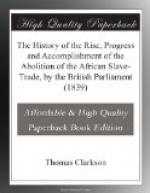In 1774, he came to England, but his attention was still kept alive to the subject; for he was the person by whom Anthony Benezet sent his letter to the Countess of Huntingdon, as before related. He was also the person to whom the same venerable defender of the African race sent his letter, before spoken of, to be forwarded to the Queen.
That William Dillwyn, and those of his own class in England, acted upon motives very distinct from those of the former class, may be said with truth; for they acted upon the constitutional principles of their own society, as incorporated into its discipline: which principles would always have incited them to the subversion of slavery, as far as they themselves were concerned, whether any other person had abolished it or not. To which it may be added, as a further proof of the originality of their motives, that the Quakers have had, ever since their institution as a religious body, but little intercourse with the world.
The third class, to which I now come, consisted, as we have seen, first of the Quakers in America; and secondly, of an union, of these with others on the same continent. The principal individuals concerned in this union were James Pemberton and Dr. Rush. The former of these, having taken an active part in several of the yearly meetings of his own society relative to the oppressed Africans, and having been in habits of intimacy and friendship with John Woolman and Anthony Benezet, with the result of whose labours he was acquainted, may be supposed to have become qualified to take a leading station in the promotion of their cause. Dr. Rush also had shown himself, as has appeared, an able advocate, and had even sustained a controversy in their favour. That the two last mentioned acted also on motives of their own, or independently of those belonging to the other two classes, when they formed their association in Pennsylvania, will be obvious from these circumstances; first, that most of those of the first class, who contributed to throw the greatest light and odium upon the Slave Trade, had not then made their public appearance in the world. And, with respect to the second class, the little committee belonging to it had neither been formed nor thought of.
And as the individuals in each of the three classes, who have now been mentioned, had an education as it were to qualify them for acting together in this great cause, and had moved independently of each other; so it will appear that, by means of circumstances, which they themselves had neither foreseen nor contrived, a junction between them was rendered easily practicable, and that it was beginning to take place at the period assigned.




